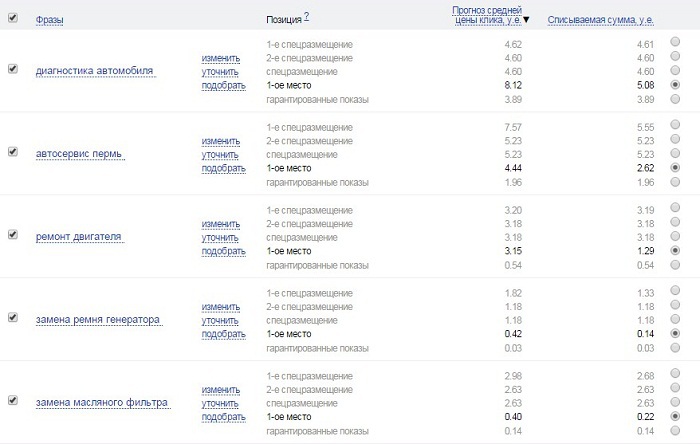3 ways to get clients from contextual advertising at the price of a business card

To get quality leads from the context at a price of 3-5 rubles, you do not need to be a cool arbitrator. In this article, you will learn three techniques that can be used with any level of skill in setting up advertising campaigns. With specific examples and with the necessary tools.
Immediately, we emphasize that teaser, banner-display networks, social networking has nothing to do with it. We are talking only about contextual advertising, in particular, Yandex Direct.
')
How to squeeze more clicks out of Yandex.Direct, preferably “clean” and inexpensive? Obviously, make more keywords. At the same time, “inexpensive” and “high-quality” almost always are mutually exclusive things. The wider the semantics, the farther the seller offers from the needs of visitors. We have to shovel the mountain of "slag" to get one diamond. What is the problem?
Near target traffic
For example, a user is looking for a "fitness club". For some reason, it is considered to be the near-target requests "sports hall", "gym", "rocking chair" and the like. These are the most targeted requests, just people formulate the same need in different ways.
Another thing is when a user has a problem and he chooses a solution: “lose weight by the summer”, “how to make a slim figure”, “how to pump up the biceps”. It’s not at all a fact that he will choose classes in a fitness club. Maybe at home he will start to study or he will sit down on some miracle pills.
It would seem that the advantages of the approach in relation to the cost of a click are obvious.
Compare the numbers here (data for one of the regions):

and here:

The frequency of near-target requests is many times less, so you need to take the amount. If you go deep, you can easily dig up a few thousand through the same Wordstat:

When you click on any position from the right side, you will receive another hundred keys. The result is a sea of cheap traffic with clicks for 2-3 rubles.
The problem is weak convertibility of near target traffic. True, it is easily corrected by setting the relevance "Request - Announcement - Landing Page".
With the first bunch there is no difficulty. The usual logic of Yandex.Direct works: a key request in the headline and in the ad text.
For example:
Request - "How to tighten the stomach after childbirth?"
Title - "How to remove the stomach after childbirth?"
Text - "Remove the stomach after childbirth in 60 days."
By the way, from this year the title can be increased by the text of the announcement. From 33 to 56 characters. If the title and the first sentence in the amount do not exceed 56 characters, the sentence is transferred to the title. This increases ad CTR by 10-15%.
Here's an option, for example:

Otherwise, Direct automatically inserts the site address:

If the sum of the header and URL exceed 56 characters, nothing is transferred to the header.
You can disable the function in the “Advanced Settings” section of the campaign parameters:

Pain and tears begin in a bunch of "Announcement - Landing Page". Users go to the page with a static offer, which is not convincing.
When a person is looking for a solution “How to lose 5 kilograms”, he has 10 possible options in his head, and the sentence “Become a member of the XXL fitness club” flies past the target. Maybe someone will catch fire in the gym, but even in this case, the user needs a benefit. Why should he turn precisely to this club, exactly how his need will be solved?
Instead of allowing near-target traffic for good luck, they need to be managed. This is how we did it in the advertising campaign for the sale of earpieces.
This tricky device helps to pass exams to careless students, so the campaign was set up for "student" requests of a non-commercial nature. Firstly, associated with passing exams:
"To pass the session ahead of time"
"Examinations for admission to the Faculty of Law"
"How to prepare for the exam in English"
right up to this: "How to pass exams if you don't know anything."
It is clear that the student does not have a direct need for earpieces. By asking such requests, he is looking for a solution to the problem - how to pass the exam is easy and simple. Therefore, we have linked its basic need with the offer with the help of dynamic content.
To do this, they synchronized the advertising campaign in Yandex Direct with the Yagla service and marked out the most conversion element for the substitution - the title. More precisely, the offer in the title.
The original version of the page:

Option with substitution for the request "To pass the session ahead of time":

Also captured such requests related to universities: "Schedule MSU journalism", "Dean's office correspondence department of Moscow State Technical University" and so on.
In general, within the framework of the campaign, near-target requests received a cost of a click at the level of 0.15 cu. (4.5 rubles). Conversion to the application from 3.6 to 5.9%. The cost of one lead - from 55 to 85 rubles. Who knows, target requests often do not gain as much, not to mention the cost of leads.
A couple more examples of using near-target traffic:
In the subject of psychological trainings for women, this is the work with the requests “Husband left”, “How to find inner harmony”, “How to look beautiful after 40”, etc.
In the topic of financial affiliate programs, these are the requests “How to make money fast,” “How to get out of debt,” “Open a business,” etc.
Targeted traffic
This is traffic on requests with the most clearly expressed need. Key words with a long "tail" of 5-6 words. The technique is used by many marketers, but the problem is in low conversions on the landing page. When the user sets an exact need, sees the proposed solution in the ad and lands on the page with the one-for-all offer, the bounce rate goes off scale.
This is how we have converted narrowly targeted traffic for auto service.
Baseline: 35 types of work related to the repair, diagnostics, prevention of cars + installation of radar detectors, DVRs, protective film. Full nomenclature - over 400 positions.
The most interesting thing started when the traffic was analyzed: 87% of visitors come for exact requests. That is, they are gaining not "Car Repair", and "Replace the oil filter", for example. Up to the indication of the model: "Replacing the alternator belt on the Lada Kalina."
They are very cheap, almost at the level of one-cent. For clarity, the rates are compared with the top queries (data by region):

What else can you take:
- Part numbers;
- Symptomatics ("Toyota Corolla knock on the engine").
The campaign in Yandex.Done is set up qualitatively, with an attractive offer in the ad:

and universal landing page:

It closes visitors for a discount or free offer (car wash, suspension diagnostics). As you can see, the offer in the title is so “battered” that a bounce rate of 96.5% is not surprising.
What did: under the narrow-purpose requests configured 324 substitutions in the header.
For example:

After 6 weeks of testing, the substitution received an increase in conversion in the application from 3.5 to 7.7%. And that is not all. At the next stage, additional adjustments were made in the CTA button: “Get replacement cost”, “Get installation cost” depending on the type of service. Conversion has grown to 8.1%.
The cost of lead - 70.3 rubles.
An important point: the growth of conversion does not work by replacing the content as such, but by creating a personalized offer for each user need. The task is to "pull out" them, based on requests, and give a strong offer. Of course, it must be true.
Associative traffic
This is the capture of “close-standing” needs when a user searches for a product from a related subject, and you “cling” to it with your offer. A well-known example is when a company selling septic tanks converted traffic for “all for giving” requests, “picnic sets” and so on. Something similar to the mechanics of offering related products in online stores, but in the context of the task is much more difficult.
Imagine: a user dreams of kebabs in nature, and you give him a bio-toilet. Laugh laugh, but the approach worked well.
Here's how we applied the associative traffic technique in an advertising campaign for the sale of an android application.
We came to the developers who have made an application to protect the vision of young children. The program is installed on the desktop. And when the child is too close to the monitor during viewing, the picture starts to blur. It turns out such a natural control: to normally watch your favorite cartoon, you need to keep a safe distance to view.
An excellent, demanded product, because for many parents the deterioration in children's vision due to the computer, TV is a real headache. Subject specific, direct requests can be counted on the fingers. The question is where else to get traffic?
Brainstorming, determined the following points:
Target audience: young mothers who sit at home with the child, and to occupy it for a while, include cartoons on the computer. That is, the direct need is absolutely non-commercial. And this, in fact, one-cent traffic for such requests as “Watch Smeshariki online.” There are a lot of them. For clarity, an example - we introduce in Yandex "Watch cartoons":

How to convert: at the heart of the campaign is the idea that it is important for mothers not only to take the child, but also to preserve his eyesight. Given that right at the time of the search, they do not think about it.
An example of one of the requests is “Watch cartoons”.
Ad Title: “Watch cartoons? - Save the child's sight "
Text: “Save your child’s sight while watching cartoons”
The heading on the landing page: “Does your child like to watch cartoons? Save him his sight with application X. "
Similarly, all other queries were converted. Synchronized campaign with Yagla (12,525 key phrases), set up substitutions in the title. To do this, we grouped all the typical requests, because the landing page does not work for the “Request = Header” Yandex.Direct logic, but to adjust the offer to a specific need.
Say, we combined “Cartoons Online”, “Cartoons for Free”, “Cartoons of 2015” and so on. The result was 95 ad groups. And only the substitution under the "branded" requests configured on the principle of direct compliance. For example: “Does your child like to watch Barbariki? Save him his sight with application X. "
Here is what it looks like in the Yagla service substitution table:

Page Conversion - 5.5%;
The cost of lead - 32.4 rubles.
Of course, the method of converting associative traffic will not work in all niches. Here you need to find a point of contact with the needs of the target audience like “I need this thing. Oh, and this is also important ”(what you sell to him).
PS Share in the comments your experience and what you think about all this.
Source: https://habr.com/ru/post/295002/
All Articles